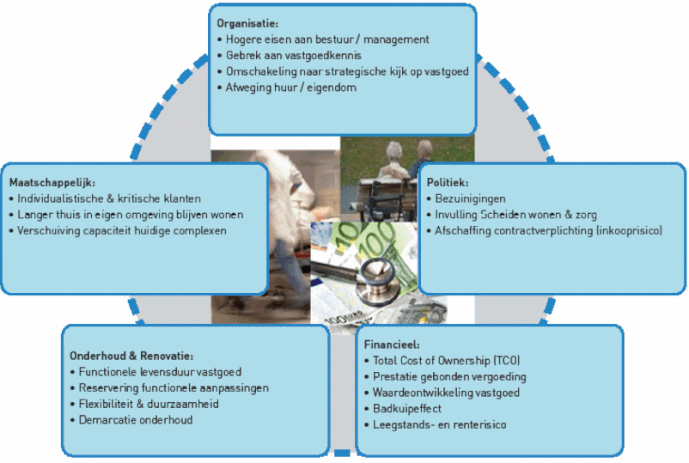Manage care institutions in a different way
Real estate policy and investment in the care sector
By taking a new direction the government wants to reform the health care sector from a supply-and risk-free system to a system where the care institutions themselves act as enterprises triggered by means of performance-related compensation. In this way they become responsible for their own investment decisions and the associated risks.
Another issue concerns the intention of the Government to start at the first of January 2014 with the separation of housing and care for the lighter care indications (ZZP 1, 2 and possibly 3). This means that clients have to pay their own housing expenses. There are still plenty of issues that needs to be arranged such as: reduction of the personal contribution to the Incapacity Benefit (AWBZ in Dutch), rent benefit and the availability of sufficient single rooms. The contract obligation of the Incapacity Benefit (AWBZ in Dutch) is also abolished in 2012. The care agencies/insurers are not obliged to completely contract all care providers. The quality of housing may lead to incompletely contract or no contract for care institutions at all, causing an increase in vacancy and introducing competitive risk. It has been decided that during the transitional regime till 2018, rates are non-negotiable.
In addition clients like to remain living for longer time at home in their own familiar environment and social network. They are also becoming more critical, more assertive and individualistic. High quality real estate and an interesting range of activities are a must for the orders inflow from new clients. Together with the separation of housing and care, this requires a different approach to the property portfolio for both intramural and extramural locations. There are three types of locations. The first type relates to the intramural locations that are only suitable for clients with a full or almost full care indication. The extramural locations (second type) are for lighter care indications and for clients who prefer to be in a protected environment of a care complex. The last type are clients are those that would like to continue to live at home, with or without support of (intensive) home care services.
The guaranteed compensation has given way to a performance-based reimbursement for care and real estate based on the actual production delivered. After a long period of uncertainty the Dutch Healthcare Authority (NZa) has given clarity about the real estate compensation provided by the policy rule CA-300-506. The summary below shows the demarcation between the various aspects of the real estate exploitation and how it should be funded.
Transition to strategic property management
The current period of political decision making, market forces, economies and social development requires a different way of managing whereby real estate is seen as an asset, whose performance should contribute to achieving the corporate objectives and care strategy. Real Estate has major influence on the efficiency, effectiveness, flexibility and balance sheet of a care institution. This requires a professional strategic real estate policy, in which it is important to fully understand the financial, functional and qualitative data and the real estate revenues generated. The real estate policy should look beyond income and expenses.
Real estate creates an added value by improving the care production, increasing customer satisfaction and wellbeing of employees, reducing costs and managing the risks. With this integrated approach, a care institution can formulate specific strategic goals and manage the organization in a responsible way.
The care companies that recognize and manage the risks of the real estate portfolio, will be more able to exploit the opportunities and develop a strong position in the market. Based on a well-founded property policy and business plan an institutional enterprise can be focussed in its business and also invest in innovative and profitable housing. The figure below shows the key risk issues for care properties.
Quick scan for NHC
In the feasibility phase, it is important to conduct a quick scan of the financial implications for the property or the investment volume of real estate initiatives. An NHC calculation tool, equipped with various rotary controls, is perfectly suited to give insight into the various income and expenses over a certain period of operation. A calculation tool has to take care of the figures and beside of that it also needs to contribute to the communication between different parties and/or departments. The calculation tool should enforce parties and/or departments to agree on the principles for determining the parameters. Experience shows that this strongly improves cooperation. In addition, in the case of rental situations, it is important to create clear demarcation lists between lessee and lessor, for both the investment as well as for large maintenance and small maintenance. These demarcation lists should be a standard part of the lease contract.
The article was published in the Handboek van de gebouwde omgeving 2012 and was posted with the permission of IGG. This article is also available as PDF.
About the authors
Hittjo Braam is a consultant for ABC Management Groep. His expertise is strategic housing management and project management in the social real estate sector, particularly the care real estate sector. He advises on revenues from the NHC and the costs of the property. Hittjo shares responsibility for the creation of the NHC calculation tool of ABC. h.braam[a]abcmg.nl Ivo Vonk, project managerbij ABC Management Groep. In recent years he gained experience in care real estate. For some time now he is also BREEAM-NL consultant. He settles ambitions of clients with the financial feasibility from the NHC and the potential for certification of sustainability measures. i.vonk[a]abcmg.nl

